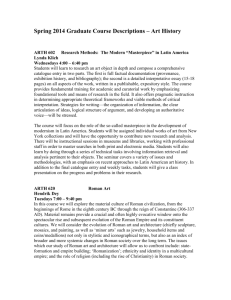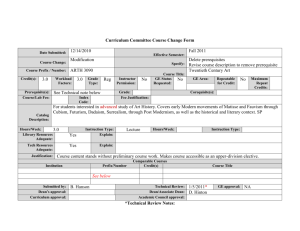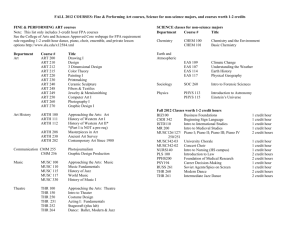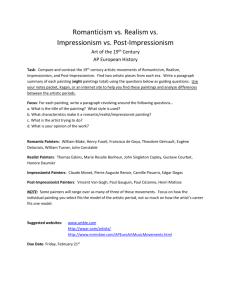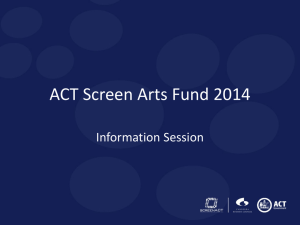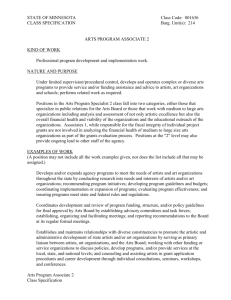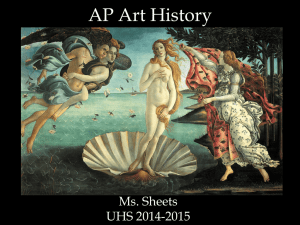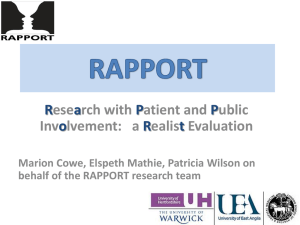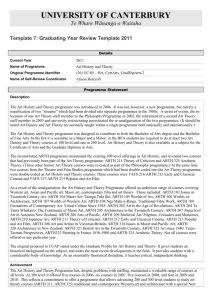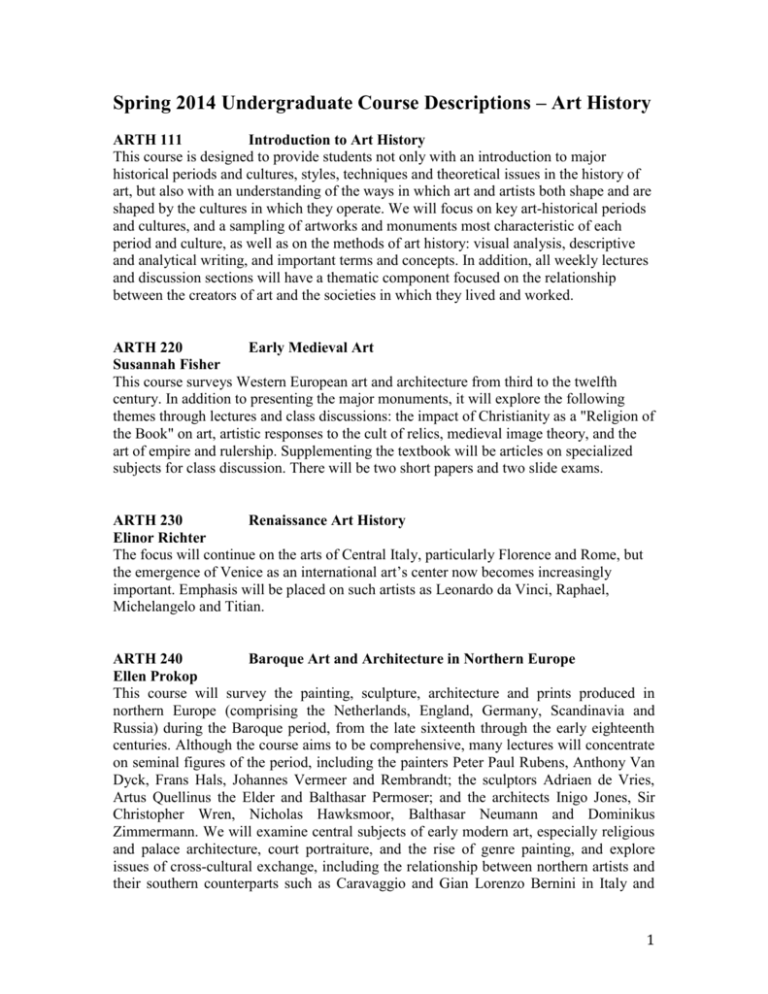
Spring 2014 Undergraduate Course Descriptions – Art History
ARTH 111
Introduction to Art History
This course is designed to provide students not only with an introduction to major
historical periods and cultures, styles, techniques and theoretical issues in the history of
art, but also with an understanding of the ways in which art and artists both shape and are
shaped by the cultures in which they operate. We will focus on key art-historical periods
and cultures, and a sampling of artworks and monuments most characteristic of each
period and culture, as well as on the methods of art history: visual analysis, descriptive
and analytical writing, and important terms and concepts. In addition, all weekly lectures
and discussion sections will have a thematic component focused on the relationship
between the creators of art and the societies in which they lived and worked.
ARTH 220
Early Medieval Art
Susannah Fisher
This course surveys Western European art and architecture from third to the twelfth
century. In addition to presenting the major monuments, it will explore the following
themes through lectures and class discussions: the impact of Christianity as a "Religion of
the Book" on art, artistic responses to the cult of relics, medieval image theory, and the
art of empire and rulership. Supplementing the textbook will be articles on specialized
subjects for class discussion. There will be two short papers and two slide exams.
ARTH 230
Renaissance Art History
Elinor Richter
The focus will continue on the arts of Central Italy, particularly Florence and Rome, but
the emergence of Venice as an international art’s center now becomes increasingly
important. Emphasis will be placed on such artists as Leonardo da Vinci, Raphael,
Michelangelo and Titian.
ARTH 240
Baroque Art and Architecture in Northern Europe
Ellen Prokop
This course will survey the painting, sculpture, architecture and prints produced in
northern Europe (comprising the Netherlands, England, Germany, Scandinavia and
Russia) during the Baroque period, from the late sixteenth through the early eighteenth
centuries. Although the course aims to be comprehensive, many lectures will concentrate
on seminal figures of the period, including the painters Peter Paul Rubens, Anthony Van
Dyck, Frans Hals, Johannes Vermeer and Rembrandt; the sculptors Adriaen de Vries,
Artus Quellinus the Elder and Balthasar Permoser; and the architects Inigo Jones, Sir
Christopher Wren, Nicholas Hawksmoor, Balthasar Neumann and Dominikus
Zimmermann. We will examine central subjects of early modern art, especially religious
and palace architecture, court portraiture, and the rise of genre painting, and explore
issues of cross-cultural exchange, including the relationship between northern artists and
their southern counterparts such as Caravaggio and Gian Lorenzo Bernini in Italy and
1
Diego de Velázquez in Spain, and patronage, particularly the development of an art
market for a middle-class audience. Finally, we will analyze how religion, ideologies,
politics and socio-economic conditions affect the visual arts.
Requirements will include two examinations, one research paper focusing on a work of
art in a New York City collection (approximately 2,000–2,500 words), and active class
participation. The assigned reading will comprise one survey textbook and a series of
articles, essays and books chapters.
ARTH242
American Architecture & Urbanism
Anna Jozefacka
This course surveys the major tendencies in architecture and urban design in the United
States, from the pre-colonial era through to the early twentieth century. Though
chronological in format, the illustrated lectures will explore the thematic undercurrents
and conditions that influenced the character of architecture in this country. While
discussing the built environment, we will take into account such forces as cultural and
national identity, industrialization, urbanization, and consumer culture. They will be
discussed in addition to the regional and environmental conditions relevant to
architecture. In this class, students will become familiar with the work of key figures of
the American architectural scene as well as with general/popular building trends. They
will learn of period aesthetic currents and their architectural evocations, and become
acquainted with those building types ‘invented’ in the United States, such as the saltbox
and skyscraper. In terms of requirements, there will be a midterm, final, and term paper.
ARTH 243
Eighteenth-Century European Art
Kim de Beaumont
This survey of European art from around 1700 to 1790 will focus primarily on Italian,
French, and British art, stressing the interplay of distinctive national developments and
major international trends. Special attention will be given to the role of the
Enlightenment and other complex political, literary, and cultural forces in transforming
life and thought in Europe throughout the period. The “hierarchy of genres” imposed by
artistic academies will be considered in relation to the increasing pluralism of artistic
activity among celebrated artists and many lesser known figures. It was in mideighteenth-century Paris and London that the art world as we know it today began to
emerge, with its focus on art exhibitions and auction houses, published art criticism and
appreciation for art among a growing middle-class public. Outstanding achievements in
sculpture and architecture, as well as the decorative arts and book illustration, will be
addressed.
Course requirements include mid-term and final examinations in essay format, and a 6-10
page term paper on a work of eighteenth-century art in a New York museum.
ARTH 245
Nineteenth-Century Art: Europe and England 1845-1900
2
Susanna Cole
This course studies the emergence, cultural significance, and accomplishments of the
second half of the 19th century avant-garde in Europe and England. Lectures cover a
variety of topics including the development of an urban mentality, gender issues,
colonialism, industrialization, idiosyncrasies of individual artistic movements and the
changing relationship of avant-gardism to bourgeois society.
ARTH 246
American Art, 1760-1900
Kevin Avery
This course illuminates the major masters and movements in American painting from
about 1760 to 1900, tying trends in artistic expression to contemporaneous historical and
cultural manifestations and transitions during the birth and earlier history of the United
States. The course concentrates on major masters in the principal genres of painting
during the period: in portraiture, John Singleton Copley, Gilbert Stuart, and Charles
Willson Peale, James A. M. Whistler, Thomas Eakins, and John Singer Sargent; in
historical and narrative painting, Benjamin West, Copley, John Trumbull, William
Sidney Mount, Eastman Johnson, and Winslow Homer; and in landscape, Thomas Cole,
Frederic Church, and other representatives of the so-called Hudson River School. Also
included are late nineteenth-century trends such as American Impressionism and
Romantic Expressionism, exemplified respectively in the works of such artists as Childe
Hassam and Albert Pinkham Ryder.
ARTH 249
20th Century Art
Stephanie Peterson
This course will focus on major art historical movements in Europe and North
America in the first half of the twentieth century. Primary source texts will provide
the foundation for a greater understanding of the social, political, and aesthetic
concerns driving these movements. Beginning with Post-Impressionism, this course
will provide a survey of Cubism, Expressionism, the return to order, Social Realism,
Constructivism, Dada, and Surrealism, culminating with the emergence of the New
York School in the 1940s. Emphasis will be placed on contextualizing each
movement in its respective artistic center and time period, while examining
exchange across international boundaries.
ARTH 251
Contemporary Art
Sarah Mills
This course focuses on art made within the last thirty years from around the world.
After beginning with a brief review of key issues springing out of postmodernism in
the 1960s and 1970s, both a chronological and thematic path charts the relevant
debates within art and the art world in the remaining decades. Themes will vary
from medium-specific art (photography, video/digital, graffiti,
3
performance/participatory) to topics of visual culture, new modes of art exhibition
and critical issues within contemporary art criticism. The course also deals as much
as possible with the local art scene and current debates, such as the razing of Five
Pointz in Long Island City. Visits to artists’ studios and New York City’s galleries and
museums will be required.
ARTH 300
Research Methods in Art History: New York Architecture
Anna Jozefacka
Using architecture of New York City as the area of inquiry, this class will familiarize
students with various methodologies and theoretical models (critical theories) that art and
architectural historians have developed to analyze painting, sculpture, and
architecture. Intended for upper level art history majors, this class is designed to help
students acquire analytic and interpretative skills for the discussion of art and
architectural works. It will also provide aid toward the acquisition of effective academic
research and writing skills. For these reasons, the class is organized around a series of
workshops and exercises that focus on practical aspects of researching, writing, editing,
and presenting an art history paper that is based on a specific object, in the case of this
class, a building.
At the beginning of the semester, each student will be assigned a building located in New
York, which he/she will analyze and research during the course of class. The result of
his/her effort will be a research paper and a new contribution to the field of architectural
history.
ARTH 300
Research Methods in Art History: The Mexican Renaissance
Lynda Klich
Students will learn to conduct in-depth research on a single art object and write a
comprehensive historiographical research paper (12-15 pages) on all aspects of the work.
The course provides fundamental training for academic scholarship by emphasizing
foundational tools and means of research in the field. It also offers pragmatic instruction
for determining appropriate analytical or theoretical frameworks and viable methods of
critical interpretation. Strategies for writing—the organization of information, the clear
articulation of ideas, logical structure of arguments, and developing an authoritative
voice—will be stressed.
Student research will focus on Mexican modernist works from New York collections.
There will be instructional sessions in museums and libraries, working with professional
staff in order to master searches in both print and electronic media. Students will also
learn by doing through a series of technical tasks involving information retrieval and
analysis pertinent to their objects. In addition to the final paper and bibliographical tasks,
students will be required to complete weekly reading and response assignments
(including an open-notes exam) and will give oral presentations on their research.
4
ASIAN 330.53
Asian American Art History
Midori Yamamura
Wednesdays, 9:10am-12:00 pm
This introductory course will explore how Asian Americans` unique history in the United
States, along with their sociopolitical and cultural positioning, distinctively shaped their
creative expressions. Students will be introduced to a broad survey of Asian American art
and explore issues of race, identity, cultural hybridity, U.S. colonial-/postcolonialism,
gender, alternative artistic strategies, and social activism that continuously helped
transform the status of Asian Americans in U.S. society. Students will analyze how Asian
American arts from diverse cultural heritages—including Chinese, Japanese, Korean,
Filipino, Vietnamese, Cambodian, and South Asian—serve as the foundations for Asian
American arts. Students will examine key moments of Asian American History: the laws
of 1882 (Chinese Exclusion Act); 1917 (Asian Indians); 1924 (Koreans and Japanese);
1934 (Philippine immigrants), and U.S. wars against Asia—The Philippines (1899-1910);
Japan (1941-45); Korea (1950-53); Vietnam (1965-75); and Afghanistan (2001-present).
Students will be expected to produce regularly assigned reading responses, a written
analysis of a current exhibition featuring Asian American artists, and a final research
paper developed in consultation with the instructor.
***Cross Listed with Asian American Studies: Search CUNYFirst under ASIAN***
ARTH 351
Special Topics in Modern Art: Photography in Latin America
Iliana Cepero Amador
This course examines the history of Latin American photography, from the early
photographic productions of the nineteenth century to the contemporary conceptual
tendencies. We begin with photographers’ representations of the local landscape and its
inhabitants, we continue with the establishment of the first photographic studios, and we
follow with the advent of modernist trends, such as surrealism and abstraction. We
approach the strong documentary practice in the region that swings from registering the
everyday life and autochthonous rituals, to chronicling political upheavals—as
exemplified in the Mexican and Cuban revolutions—, to cataloguing the “disappeared”
under the military juntas of Argentina and Chile. We also explore the role of photography
for the construction of a political figure as in the first Peronism (1946-1955), the
treatment of labor in 1970s Cuban and Brazilian photo essays, the incorporation of
postmodern concepts by Latin American photographers in the 1990s, and the
photographic representations of narco-culture. We discuss critical problems such as:
realism, indigenism, social commentary, propaganda, nationalism, violence, and ethics.
Some protagonists of this story: Martín Chambi, Manuel Alvarez Bravo, Graciela
Iturbide, Sebastián Salgado, Alberto Korda, Mario Cravo Neto, Sara Facio, Luis
González Palma, Marta María Pérez, and Vik Muniz.
ARTH 351 Special Topics in 19th Century Art
Susanna Cole
5
This course examines the development of art in Europe and England from the 1780’s to
1900. It will explore topics including, but not limited to, revolutionary practices, the
avant–garde, modernity, primitivism, mass–culture, industrialization, and urbanism
through the works of major figures from David, Goya, Turner, Manet, Seurat and
Cezanne. The course will cover artistic movements including the neo-classical,
romanticism, realism, landscape, impressionism, post-impressionism and symbolism.
ARTH 351
Special Topics: Sound Art
Meredith Mowder
While the term “sound art” only came into being in the 1980s, sound in the visual arts has
a far longer history, ranging from Modernist experiments with synesthesia to the avantgarde exploits of Dada and Futurism. Sound art also has a distinctly musical heritage,
emerging from the compositional experiments of John Cage, Tony Conrad, La Monte
Young, Maryanne Amacher, and Pauline Oliveros, among others. This course aims to
trace a history of sound in the arts in the 20th century from the historical avant-garde to
the present. We will spend significant time listening to landmark recordings in this
history, as well as discussing why, even today, the term “sound art” remains elusive. We
will cover the historical and theoretical groundwork needed to consider the boundaries of
sound art, the differences between sound art and music, exhibition strategies, and what
sound may offer the visual discipline of art history.ARTH 371
Arts of Japan
Eileen Hsiang-ling Hsu
This course examines major aesthetic, cultural, and religious developments as reflected in
the arts of Japan from the prehistoric period to the present. Topics include handscroll
(emaki) and screen (byōbu) painting, Buddhist sculpture, ceramics, woodblock prints
(ukiyo-e) and garden design. As Japanese culture is characterized by the constant
interaction between its native spirit and outside stimuli, the patterns of artistic
transformation and innovation are examined with regards to each phase of this
interaction. While continental influences are clearly the dominant theme, there are
periods when the native aesthetics and sentiment inspire a unique artistic expression,
reflecting Japanese people’s deep emotional connection with nature and its poetic and
Zen-inspired attitude towards human affairs. The contrast between the wholesale
adoption of continental models, chiefly Chinese, and the flowering of native sense for
harmony and beauty, as well as the ingenious synthesis between the two extremes of the
pendulum, will be emphasized throughout the course.
Requirements:
Mid-term exam, final exam, and term paper . Students may improve their academic
standing by slide presentations based on the term papers.
Main texts:
Mason, Penelope. History of Japanese Art (Upper Saddle River, N.J.: Pearson Prentice
Hall, c2005)
Supplemental Reading:
6
Stanley-Baker, Joan. Japanese Art (New York: Thames and Hudson, 2000)
Murase, Miyeko. Bridge of Dreams: the Mary Griggs Burke Collection of Japanese Art
(New York: Metropolitan Museum of Japanese Art. 2000)
ARTH 381.03 Art and Visual Culture of the African Diaspora in Latin America
Linda Rodriguez
This course will focus on the art and visual culture of the African diaspora in Latin
America (with some material from Africa, Spain, and Haiti). We will first explore the
idea of diaspora and the different ways that historians, anthropologists, and art historians
have studied African diasporic cultural and artistic practices in the Americas. We will
examine the art and visual culture of sacred contexts – like that of Santería in Cuba and
Candomblé in Brazil (among others) – as well as art created by artists of African descent
outside of those contexts. To bring these secular and sacred spheres together, we will ask
how artists have viewed the intersection of race and artistic practice. Did they view
themselves as members of a diaspora? What were the cultural politics of artistic
production that they confronted? Is art of the African diaspora always “self-consciously
diasporic”?
ARH 420 Advanced Studies Seminar in Medieval Art: Saints, Relics, Reliquaries
Cynthia Hahn
Medieval reliquaries have recently been the subject of a major exhibition that traveled
from Cleveland, to Baltimore, to London. Why are reliquaries of interest to modern
museum goers?
A short answer is that they are strangely beautiful containers crafted of gold and gems to
hold something often considered valueless--old bones and/or dust. A longer answer
considers their central and important place in medieval society.
Much of medieval artistic production was created to ornament churches and in turn
churches were ornamented to be pleasing to God and worthy of his saints. Architecture,
sculpture, textiles, and especially reliquaries were created to celebrate saints and their
relics.
This course will consider shrines, manuscripts of saints' lives, and reliquaries in their
varied ability to "adequately" represent and communicate the power of the saintly.
Students will do a wide variety of readings, write and present a research paper (most
likely on an object in the Metropolitan Museum of Art). The Class will visit the Morgan
Museum and the Met at least twice, and the Cloisters if possible. We will discuss these
collections with their medieval curators. In preparation for the course, students should
visit the Hildesheim show currently at the Met, closing on Jan 5.
ARTH 450
Advanced Studies Seminar in Modern Art: The New York School
7
Howard Singerman
The New York School seminar will focus on the background, development, and
dissemination of abstract expressionism, beginning with readings on the place and
politics of the artist in America in the 1930s. Through primary source documents
and secondary literature, the course will examine the social and intellectual grounds
of the subjects of abstract painting in the 1940s and the emergence of New York as
an international art center in the 1950s. Among the artists we will address in depth
are Jackson Pollock, Willem de Kooning, Barnett Newman, and Ad Reinhardt. One
particular area of interest for the course will be the ways in which the rise of the
New York School intersects with New York’s art institutions, from the Whitney and
the Modern to the New School, NYU, and Hunter College—where William Baziotes,
Ad Reinhardt, and Robert Motherwell taught.
8

